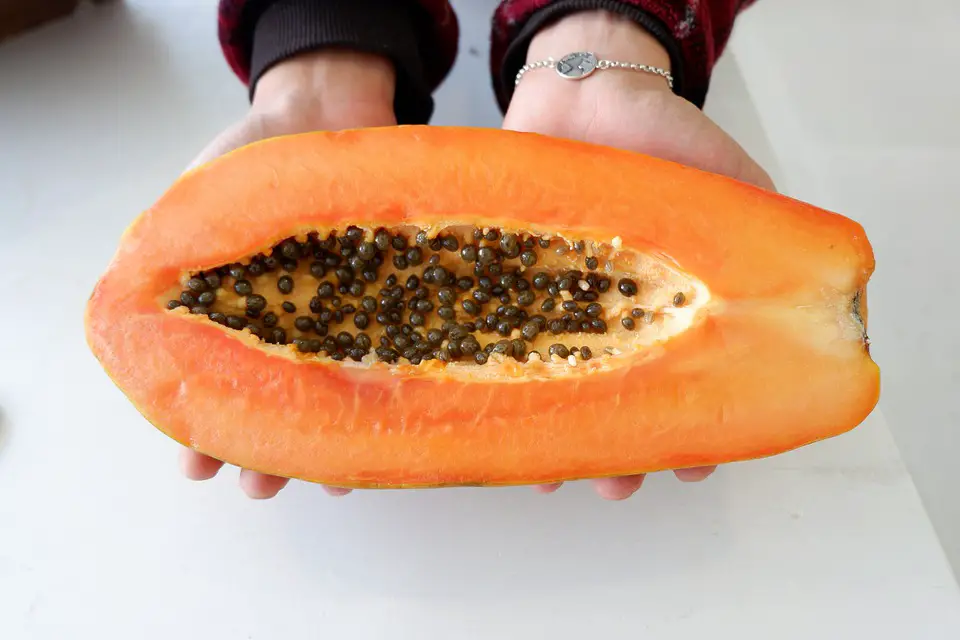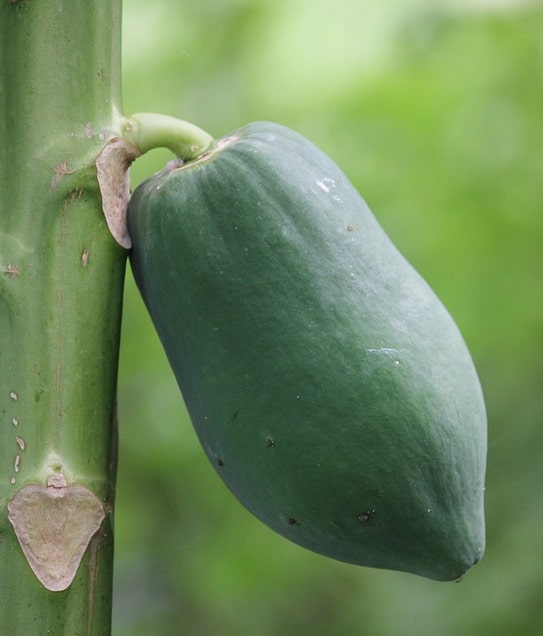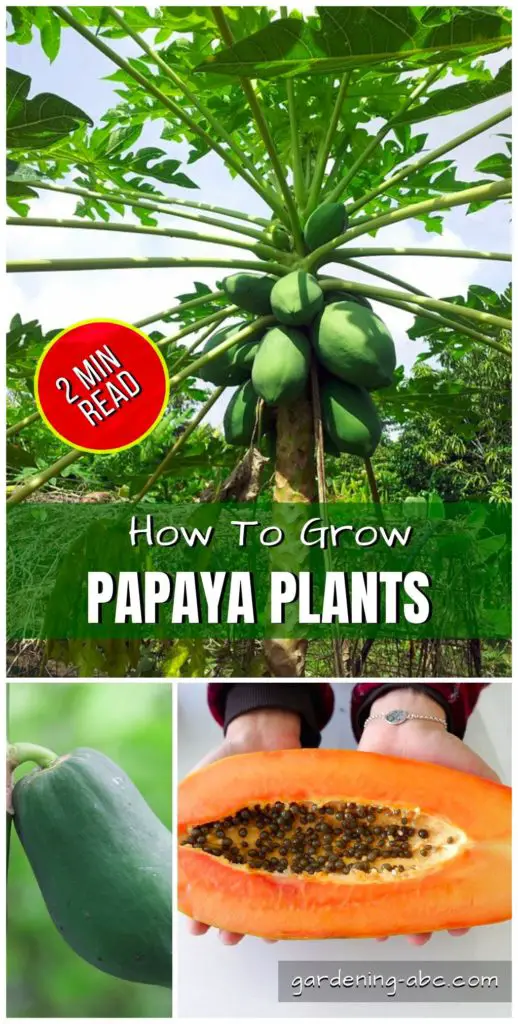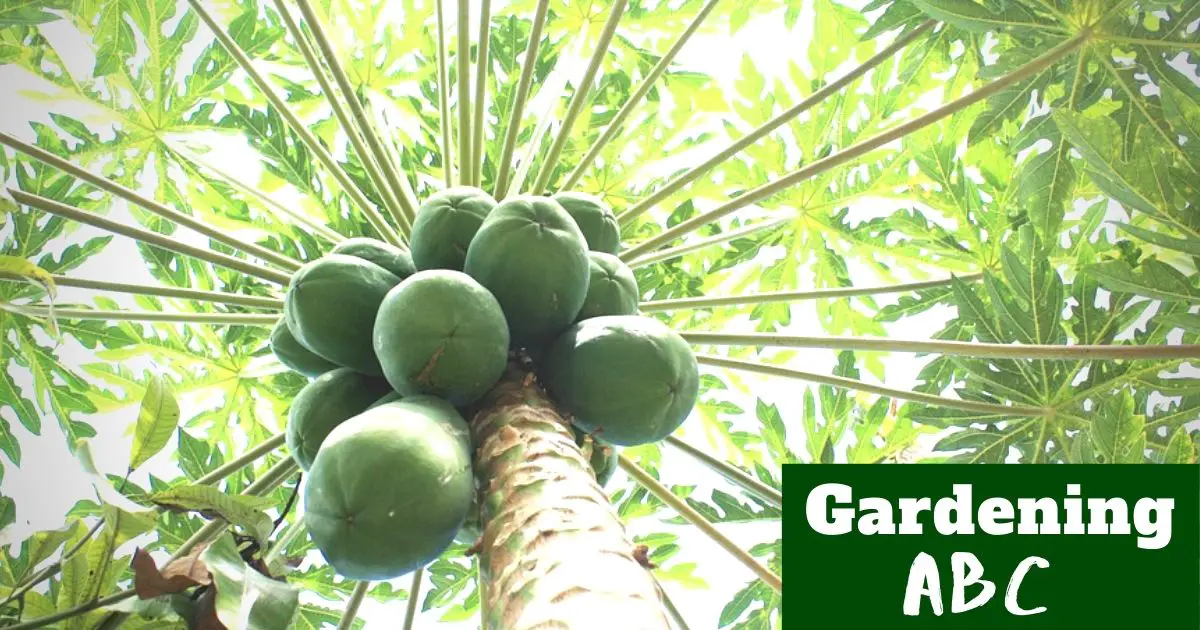We use affiliate links to run our site. When you buy through links on our site, we may earn an affiliate commission, without any added cost to you. Learn more
Papaya trees are a beautiful addition to your garden. A papaya plant is fairly simple to grow, and easy to maintain and the fruits will be ready to eat within 8-12 months.
So if you are looking for how to grow papaya from seeds, this post is just for you.
In this detailed tutorial, I will take you from planting papaya seeds to getting a bountiful harvest. With a little hard work and a lot of patience, you can grow this rewarding tropical fruit in the comfort of your own backyard.
Ideal Site For Growing Papaya Trees:
The best site for growing a papaya plant is a place where you get full sun exposure. Also, the site should not get flooded after rainfall.
How To Grow Papaya Plants:
Growing papaya doesn’t require a lot of space, you can grow a papaya tree in containers on a patio or balcony. All you need is some warm weather, a few supplies, and a little bit of patience.
Though you can grow papayas by tissue culture and rooted cuttings, the best way to grow a papaya plant is from the seeds. First of all, it’s much cheaper to grow papayas from seed. Secondly, it’s incredibly easy to do – even kids can do it!
How to Grow Papaya From Seeds:
For growing papayas from the seed, the first step is to separate the seeds from the fruit. Here’s what you need to do:
First, cut a ripe papaya fruit in half and then take out all the seeds. Notice, the seeds are covered in some jelly-like substance. Squeeze the seed out of that coating. This coating inhibits seed germination.

Now, wash the seeds thoroughly with clean water and then place them on a paper towel to dry. Once they are totally dry, you can use these for papaya plantations. Store the excess seeds in a plastic bag for later use.
Now that you have the seeds, you can plant them and start growing your own papaya tree.
How to Plant Papaya:
Papayas are very sensitive to root shock, so plant the seed where you want to grow your papaya tree. The transplantation process can really hurt the plant. Select the place where you want to grow the plant.
Many papaya growers grow their papaya seedlings in bio-degradable pots. They can then transplant the seedlings directly to the ground with very little disturbance to the roots.
As a papaya plant can be male, female, or bisexual, so, grow at least 2-3 plants in your garden to ensure enough fruit production.
Before planting the seeds make sure you have mixed enough compost with the soil. They are very voracious feeders so make sure you have provided them with enough to eat.
The spacing required for each plant is a minimum of 1.5 meters, keep this in mind while planting.
If you read our blogs regularly you would have known by now that papaya plants require full sun; More the better. Though you can grow papayas in partial shade; the fruiting will be late and the tastes will not be very good.
Fertilizers For Papaya Plants:
The best way to fertilize your papaya plant is to apply a little fertilizer at regular intervals. For example, when your plants are young, apply 1/4 lb of a balanced fertilizer twice a month.
Increase the amount and the frequency as your plant grows larger.

How To Water A Papaya Plant:
Watering is crucial for the proper growth and fruit production in the papaya plant. As papaya plants are generally grown in warmer conditions and have large leaves (they transpire a lot of water), you can not give too little water to a papaya plant.
Lack of water will make your papaya plant drop flowers, leaves, and young fruits. Also, the produced fruits will be smaller and will have low sugar content.
If you are growing your papaya in sandy soil, water your plants on alternative days. You might even have to water every day during very hot or dry weather. This is because sandy soil does not hold much water and is very well-drained.
On the other hand, if your papaya plant is in the soil where the water holding capacity is far better you might give a 3-4 day interval.
Papaya plants are also very susceptible to root rot. So choosing the right amount of water is very important. Giving more water than required, and you end up harming the plant.
Papaya Companion Plants:
Companion planting is an important part of sustainable gardening, and by choosing the right companion plants for papaya, you can create a thriving ecosystem in your own backyard.
There are many benefits to planting companion plants with papaya trees. The most obvious benefit is the increased production of fruit. However, there are also several other benefits including improved pollination, pest control, and soil health.
Some of the best papaya companion plants are legumes, beans, peppers, bananas, different types of flowers, sweet potatoes, etc.
Each of these plants provides different benefits to the papaya plant, helping it to grow and flourish. For example, beans increase soil fertility by adding nitrogen to the soil, while chili peppers help to deter pests. Many flowers invite pollinators to the garden.
So whenever possible try to grow these plants along with your papaya tree.
Use Mulch:
You can always go for mulch to help you in watering your papaya tree. Mulching papaya trees helps retain soil moisture, reduces weed problems, and improves the soil near the surface.
For mulching use bark, wood chips, or similar mulch material. Apply a layer of 2-6 inches and keep a gap of 8–12 inches from the trunk.
The Ideal Soil For A Papaya Plant:
Papayas are a tropical fruit that thrives in hot, humid climates. The best soil type for growing papayas is loamy soil. But you can also grow papayas in well-drained, sandy soil with plenty of organic matter.
A pH of 5.5 to 7.0 is ideal for papayas. The plants are relatively drought tolerant but prefer consistent moisture during the fruiting season.
Types of Papaya Plants:
Papaya is a polygamous plant and can be of 3 types: male, female, and bisexual.
Male (staminate) plants have small, tubular, yellow flowers that have 10 anthers held in cymes at the ends of long peduncles.
Female (pistillate) plants have large yellow to whitish flowers that have a large, superior ovary, held on a much-reduced cyme in the leaf axils along the trunk.
Bisexual (hermaphroditic) plants have perfect flowers held on a much-reduced cyme in the leaf axils along the trunk.
It is important that your garden has at least some female or bisexual plants. The male plant will not bear the fruits. You should have a 1: 10 ratio of male and female plants for a healthy yield.
Papaya Flowers:
Papaya flowers are either male or female. Male papaya flowers have long, thin petals and a central stalk that is filled with pollen. Female papaya flowers have shorter, thicker petals and a central ovary that will develop into the fruit.
Generally, papaya will start flowering once it becomes more than one meter in height. Expect to harvest the ripe papayas within a year.
Papaya Fruits:

The best part of growing papaya is that, unlike most plants, you will get fruits all year long. The fruits have very smooth skin and can be of various shapes.
Papaya fruits usually have many seeds surrounded by a smooth yellow to orange-red fleshy coating.
The only problem is with time papaya plants become taller (it will become difficult to pluck the fruits) and much more prone to diseases. Also, older plants tend to flower much less than younger ones.
Pruning of A Papaya Tree:
The main growing point of a papaya plant is terminal, so most of the time you don’t need to bother about any major pruning.
Sometimes, in mature papaya plants though, you might see some side shoots, especially when the main growing point is damaged. Here, select 1 or 2 of the most vigorous shoots and remove the rest of the branches. This will ensure the growth and fruiting of the remaining shoots.
Remove any dead leaves on the plant. It will clean up the plant and also reduce diseases and pest problems.
How To Shorten A Papaya Tree:
Papayas are tropical fruits that can grow up to 20 feet tall. However, you can easily shorten a papaya tree by following a few simple steps. This will make it easier to pick the fruit and keep the tree healthy.
There are a number of things you can do to shorten a papaya tree and keep your tree to a more manageable size.
Once the papaya tree grows up to 6 inches cut the top off the tree. If you do it continuously this will result in a thicker trunk. Always use disinfected, sharp and clean tools. Otherwise, it might result in diseases.
Keeping your papaya tree short and shrub-like is always better than allowing it to grow up to a full-sized tree.
For container gardeners, keeping a papaya tree short is crucial. So you must prune your papaya tree and keep it a good size for growing in pots.
Even If you are not growing papaya in containers keeping your tree dwarf will help you to harvest your papaya. Because it will be in arm’s reach and not way up high in a tall tree.
Harvesting Papayas:
Papaya fruits are harvested in both green and ripe forms. For ripe fruits pick them when the yellow color covers 1/10th to 1/3 rd of the surface.
After harvesting, keep them at room temperature to fully ripen. After that store them in the refrigerator for up to 4 to 7 days.
Common Pests Of A Papaya Tree:
Papaya Fruit Fly:
They lay eggs in the fruit cavity. When the eggs hatch, the larva eats up the fruit from inside and damages the whole fruit while emerging.
You will find fruits are having yellow areas and might drop prematurely from the plant.
Place a paper bag or paint strainer cloth over individual fruit when they are small and leave the bag on until harvest.
Papaya Webworm:
They develop under a web between and around fruits and along the stems of the papaya plants. The webworms affect fruit and stem. They also encourage fungus diseases.
You can easily remove them by hand or use a garden hose to spray a strong jet of water.
Papaya Whitefly:
They mainly affect the papaya leaves and cause them to drop. They also reduce fruit production in the papaya plant.
The best way to control this is to remove the affected papaya leaves and apply organic pest control measures.
Two-spotted Mite:
This also affects papaya leaves and causes defoliation and early leaf drop. You might see browning of the leaf surface and eventually skeletonizing of the leaves.
Nematodes:
Nematodes also affect your papaya plant. They feed on the roots, causing plants to decline in vigor. This also makes your papaya plant susceptible to toppling over because of the weak roots.
Before planting, make sure your soil is free from harmful nematodes. Here are some suggestions on how to make your soil nematode-free.
Plant in areas with clean soil, and avoid areas of the landscape with known nematode problems.
Diseases Of A Papaya Plant:
Following are some of the most common diseases of a papaya plant:
Anthracnose:
This disease affects mainly the mature papaya fruit. Fruits show water-soaked spots. These, in turn, will enlarge and becomes brown or black. It creates paths for consequent fungus infections.
Papaya Ringspot Virus:
This is one of the most prominent diseases of a papaya plant. Symptoms include yellow mottlings of leaves and vein clearing of younger leaves. You might also see distorted leaf lobes. Blistered, narrow, etc.
Removing the infected papaya trees is by far the best solution in this situation.
Powdery Mildew:
This affects papaya leaves. You will find white or light yellow spots on the surface of the leaves. The areas of the leaves will then fall off that would creating holes in the leaves.
Control includes removing infested leaves and removing them from near the plants.
Phytophthora Blight:
The plant suffers damping-off, root rot, stem rot, and fruit rot. These eventually lead to plant death.
Corynespora Leaf Spot:
Here leaves start to show small, yellow areas which later expand into larger (0.2–0.4 inches) circular brown spots.
Nutritional Value of Papaya:
Papayas are very nutritious fruit. You can have them ripe or raw. They are rich in vitamins A, C, and E, Calcium, Potassium, Magnesium, and Phosphorus.
I hope after learning all the basics of how to grow papaya trees from seeds you can easily go papayas in your house. If you liked the article share it with your friends.
Happy Gardening!!!

Amazon and the Amazon logo are trademarks of Amazon.com, Inc, or its affiliates.
